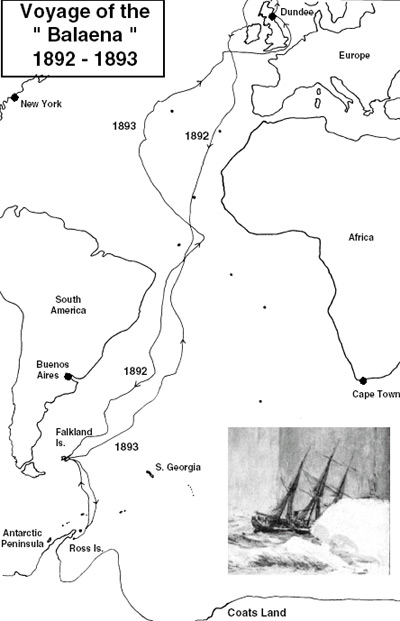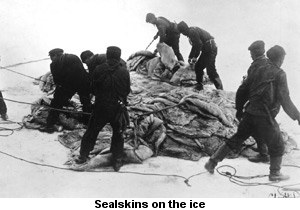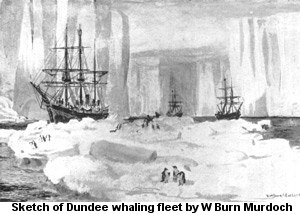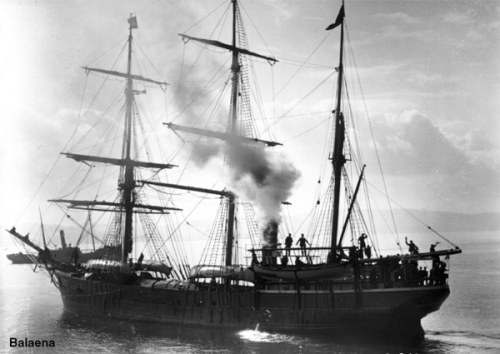
| Glasgow Digital Library | Voyage of the Scotia | BRUCE | PEOPLE | SHIP | ANTARCTIC | INDEX |
|---|

In the late nineteenth century whales in the Arctic area of the North Atlantic were becoming scarce - in particular the right, or bone-bearing whale (balaena mysticetus). James Clark Ross in his exploration of the Antarctic in the 1840s had reported similar whales in the Southern Ocean.
In 1892, a fleet of Dundee whalers belonging to Robert Kinnes (Balaena, Active, Diana and Pole Star) sailed on an investigative expedition to the Antarctic looking for whales. The fleet required a surgeon and naturalist to sail with them and the scientific community suggested William Speirs Bruce. Bruce had not completed his medical studies but was well known for his interest in oceanography. His assistant was to be the artist William Gordon Burn Murdoch who was commissioned by Longmans the publishers to write an account of the voyage.
Whale oil had been used for street lighting but at this time was being replaced by paraffin. The oil was still used in Dundee's leading industry of jute manufacture and in the tanning industry. The main prize from whaling, however, was the baleen from the whale's jaws. Baleen - or plates of whalebone - was used by the whale for filtering plankton, their main diet. The whalebone from one whale could fetch between £2,000 and £3,000, a considerable sum at the time. The main use was the stiffening of ladies' dresses and corsets.
Bruce and Burn Murdoch sailed on Balaena which was under the command of Captain Fairweather, 'a wily veteran of ice navigation'. Fairweather took little interest in the work of Bruce and Burn-Murdoch. The crew were 'old Arctic whalers, men and boys from east coast fishing and gentlemen from the Shetland Islands'.
Balaena encountered horrific seas in the early part of her voyage south. Waves went down the funnel and a crewman on the mainyard had his sea boots filled with water. Bruce was the only crew member who was not ill on the voyage south.

The expedition sailed down to the Antarctic Peninsula as far as Ross Island. Balaena tied up to the ice in Erebus and Terror Gulf only a mile from where James Clark Ross had spent New Year's Day in 1843. Dundee Island was named by this expedition.
No right whales were found and the mighty blue whale proved too large for the harpoon technology of the day. The expedition was not a commercial success but the mass catching of seals helped pay for the voyage. Over 5,000 seals were taken, and Bruce and Burn-Murdoch were expected to help with the slaughter and flensing. This was something they both hated. There was little time for scientific work.
Burn Murdoch was to comment, 'If we lay hold of glacier rocks we raise a whirlwind of objections, yet we see albatross skins collected by the score, and rare penguins killed by the hundred, their bodies and skins chucked overboard'.
On the return journey there was a good deal of scurvy on board - despite the regulation lime juice. Bruce and Burn-Murdoch found their teeth shaky and many of the crew took to their bunks.
On the passage north many of Bruce's scientific specimens disappeared - lost or thrown overboard (the ship was heavily laden with seal skins and the captain probably thought the specimens too heavy). When the ship returned to Dundee, Captain Fairweather did not want to release Bruce's notes or the remaining specimens as he thought they would be of value to Balaena's owner. Bruce managed to retrieve his meteorological notes and some of his specimens.

Geddes was now professor in botany at Dundee. He took Bruce and Burn-Murdoch home for a meal and it was years later before he told them of the awful smell of seal oil that they brought with them that night.
Bruce's enthusiasm for polar work had been wetted: 'I am burning to be off again anywhere, but particularly to the far south where I believe there is a vast sphere for research'.
Bruce was invited to speak to prominent scientists in London about his experiences. He had to borrow money from Burn-Murdoch to get his suit out of pawn before he appeared before the scientists. Bruce had lived off salt beef, hard tack (biscuits) and penguin in the Antarctic. Now he was living on bread and water in London. In a few years' time, when on Princess Alice with the future Prince of Monaco, he was fed by the best chef in Europe - quite a contrast in his life.
After the Balaena expedition, Bruce tried to mount an expedition to South Georgia but could not raise enough funds.
Captain Fairweather returned to the Arctic whaling but was to return to the Southern Ocean in 1916 in command of Discovery to rescue Shackleton's Elephant Island party. Discovery only went as far as the River Plate as by that time the party had been rescued.

Oh the noble fleet of whalers out sailing from Dundee,
Well-manned by British sailors to work them on the sea;
On the western ocean passage none with them can compare
For there's not a ship could make the trip as the Balaena, I declare.
And the wind is on her quarter and her engine working free,
And there's not another whaler a-sailing from Dundee
Can beat the aul' Balaena, and you needn 't try her on,
For we challenge all both large and small from Dundee to St John's.
| Glasgow Digital Library | Voyage of the Scotia | BRUCE | PEOPLE | SHIP | ANTARCTIC | INDEX |
|---|